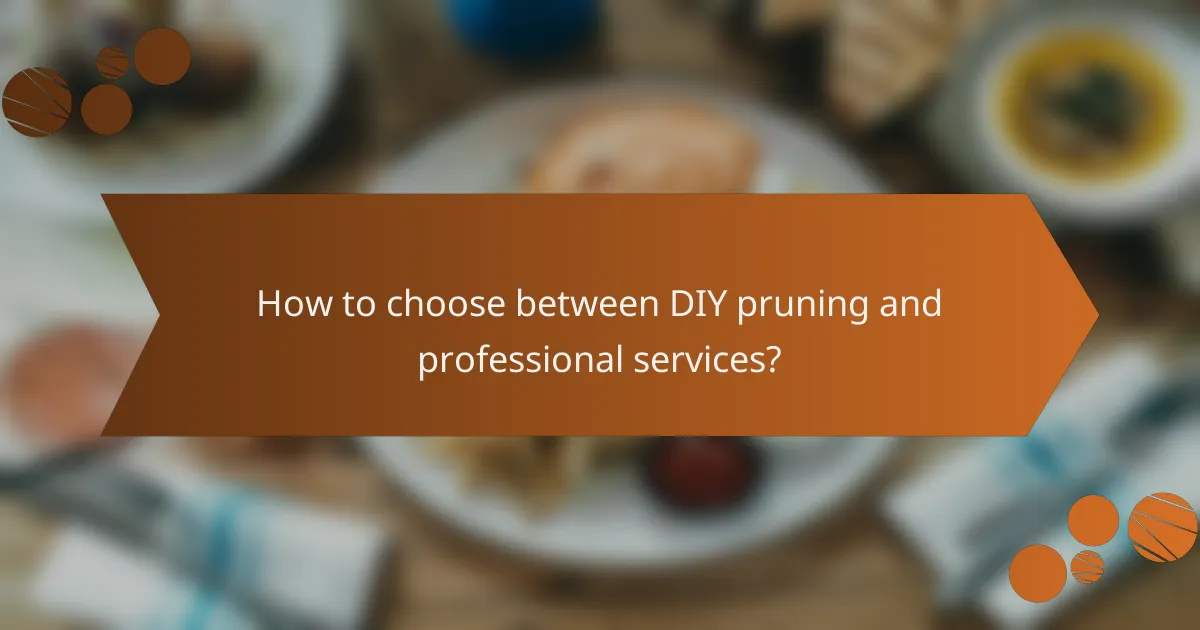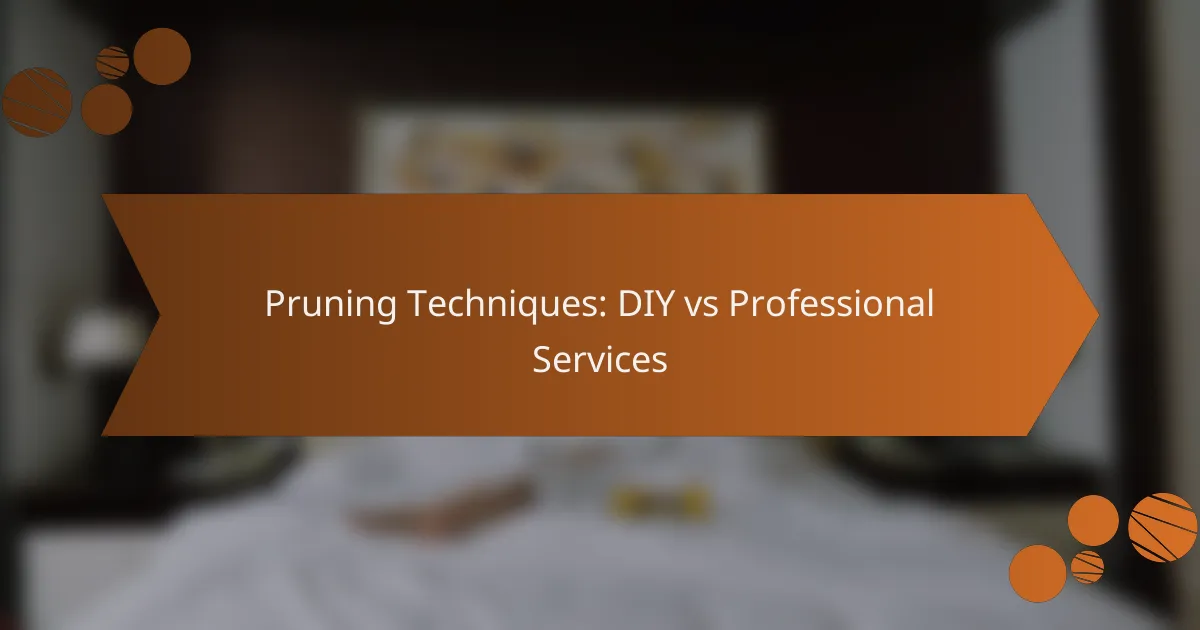Pruning is an essential practice for maintaining healthy gardens and landscapes, particularly in regions like Los Angeles. Homeowners can choose between DIY techniques, such as thinning and heading cuts, or opt for professional services that provide expertise and efficiency. Understanding the best methods and timing for pruning can greatly enhance the health and aesthetics of your plants.

What are the best pruning techniques for homeowners in Los Angeles?
Homeowners in Los Angeles can effectively use several pruning techniques to maintain their gardens and landscapes. The best methods include thinning cuts, heading cuts, reduction cuts, shearing, and pinching, each serving distinct purposes for plant health and aesthetics.
Thinning cuts
Thinning cuts involve removing entire branches at their point of origin, which helps to improve air circulation and light penetration within the plant. This technique is particularly beneficial for dense shrubs and trees, allowing for healthier growth and reducing the risk of disease.
When performing thinning cuts, aim to remove about 20-30% of the plant’s foliage. Be cautious not to over-prune, as this can stress the plant. Focus on removing weak or crossing branches to enhance overall structure.
Heading cuts
Heading cuts trim back the tips of branches to encourage bushier growth and denser foliage. This method is often used on flowering shrubs to promote more blooms. It’s essential to make these cuts just above a bud to stimulate new growth.
For heading cuts, consider limiting the removal to about one-third of the branch length. This approach helps maintain the plant’s natural shape while encouraging fuller growth. Regular heading cuts can keep plants looking tidy and vibrant.
Reduction cuts
Reduction cuts are used to shorten a branch while maintaining its natural shape, often applied to overgrown trees or shrubs. This technique is effective for controlling size without sacrificing the plant’s overall form.
To perform reduction cuts, cut back to a lateral branch that is at least one-third the diameter of the branch being removed. This helps ensure that the plant can heal properly and continue to thrive. Regular reduction cuts can keep larger plants manageable in residential landscapes.
Shearing
Shearing involves cutting back the outer growth of plants to create a formal shape, often seen in hedges and topiaries. This technique can create a neat appearance but should be used sparingly to avoid damaging the plant’s health.
When shearing, aim to maintain a consistent shape and avoid cutting into old wood, as this can hinder new growth. It’s best to shear during the growing season to encourage quick recovery and regrowth, ensuring the plants remain healthy and attractive.
Pinching
Pinching is a simple technique where the tips of young shoots are removed using fingers or shears, promoting bushier growth and more blooms. This method is particularly effective for herbaceous plants and annuals.
For optimal results, pinch back the tips when the plants are about 6-8 inches tall. This encourages lateral branching and a fuller appearance. Regular pinching can help maintain a compact shape and enhance flowering in many garden plants.

When should you prune trees and shrubs in Southern California?
In Southern California, the ideal time to prune trees and shrubs generally falls between late winter and early spring, just before new growth begins. This timing helps promote healthy growth and flowering while minimizing stress on the plants.
Best time for flowering trees
Flowering trees should typically be pruned after they bloom, which is usually in late spring or early summer. This approach allows you to enjoy their flowers before cutting back any dead or overgrown branches.
For trees that bloom in early spring, such as cherry or magnolia, pruning should occur immediately after flowering. This timing ensures that you do not remove buds that will produce flowers in the following season.
Best time for fruit trees
Fruit trees are best pruned during the dormant season, typically from late winter to early spring. This period allows you to shape the tree and remove any dead or diseased branches before the growing season starts.
For stone fruits like peaches and cherries, pruning should occur in late winter, while citrus trees can be pruned in late winter or early spring, just before new growth begins. This timing helps enhance fruit production and overall tree health.
Best time for shrubs
Shrubs should be pruned based on their flowering habits. For spring-flowering shrubs, such as lilacs, prune immediately after they bloom to avoid cutting off next year’s buds.
In contrast, summer-blooming shrubs, like butterfly bush and hibiscus, can be pruned in late winter or early spring. This timing encourages vigorous growth and abundant blooms during the summer months.

What are the benefits of hiring professional pruning services?
Hiring professional pruning services offers expertise, safety, and efficiency that can significantly enhance the health and appearance of your trees. Professionals understand the specific needs of different tree species and can execute pruning techniques that promote growth while minimizing risk.
Expertise in tree health
Professional pruners possess extensive knowledge about tree biology and health. They can identify signs of disease, pest infestations, and structural weaknesses that an untrained eye might miss. This expertise ensures that pruning is done at the right time and in the right way to support the tree’s overall health.
For instance, professionals often follow guidelines from organizations like the International Society of Arboriculture, which recommend specific pruning techniques based on the species and age of the tree. This targeted approach can lead to healthier trees and better growth outcomes.
Safety and equipment
Pruning can involve working at heights and using sharp tools, which poses safety risks. Professional services come equipped with the right tools and safety gear, reducing the likelihood of accidents. They are trained to handle potentially dangerous situations, such as removing large branches or working near power lines.
Moreover, professionals often carry insurance, which protects you from liability in case of accidents during the pruning process. This added layer of security is a significant advantage over DIY efforts.
Time-saving
Hiring professionals can save you considerable time compared to doing the job yourself. Pruning can be labor-intensive and time-consuming, especially for larger trees or extensive landscapes. Professionals can complete the work efficiently, allowing you to focus on other tasks.
Typically, a professional pruning job can take a few hours to a day, depending on the scope, while DIY efforts might stretch over several weekends. This time savings can be particularly valuable for busy homeowners or property managers.

How to choose between DIY pruning and professional services?
Choosing between DIY pruning and professional services depends on your tree’s size and type, your skill level, and the time you can commit. Assessing these factors will help you make an informed decision that ensures the health of your trees and safety during the process.
Assessing tree size and type
The size and type of your tree significantly influence whether you should prune it yourself or hire a professional. Smaller trees, typically under 10 feet, can often be managed by homeowners, while larger trees may require specialized equipment and expertise.
Additionally, certain species have unique pruning needs. For instance, fruit trees benefit from specific pruning techniques to enhance yield, while ornamental trees may require aesthetic shaping. Understanding these requirements is crucial before deciding on your approach.
Evaluating personal skill level
Your skill level is a key factor in determining whether to prune your trees yourself or seek professional help. If you have experience with gardening and basic tree care, you may feel confident tackling minor pruning tasks.
However, if you lack experience or are unsure about proper techniques, hiring a professional can prevent damage to the tree and ensure safety. Consider taking a local workshop or consulting resources to boost your skills if you lean towards DIY.
Considering time availability
Time availability plays a significant role in your decision-making process. Pruning can be time-consuming, especially for larger trees or extensive landscaping. If you have limited time, hiring a professional can save you the hassle and ensure the job is done efficiently.
On the other hand, if you enjoy gardening and have the time to dedicate, DIY pruning can be a rewarding experience. Just be sure to schedule your pruning during the appropriate season for your tree type to promote healthy growth.

What tools are essential for DIY pruning?
Essential tools for DIY pruning include pruning shears, loppers, and a pruning saw. These tools help you effectively manage plant growth and maintain the health of your garden.
Pruning Shears
Pruning shears, or hand pruners, are ideal for cutting small branches and stems. They typically have a blade length of around 2-3 inches and are perfect for precise cuts on live plants. Look for models with ergonomic handles for comfort during extended use.
When using pruning shears, ensure they are sharp to make clean cuts, which helps prevent damage to the plant. Regular maintenance, such as cleaning and oiling the blades, will extend their lifespan.
Loppers
Loppers are designed for thicker branches, usually up to 2 inches in diameter. They feature long handles that provide leverage, making it easier to cut through tougher wood. Choose loppers with a bypass blade for cleaner cuts.
For optimal performance, consider the weight and balance of the loppers, as this affects your control during pruning. Always wear gloves to protect your hands while using these tools.
Pruning Saw
A pruning saw is essential for larger branches that cannot be handled by shears or loppers. These saws come in various sizes, with folding models being convenient for storage and transport. Look for a saw with a curved blade for better cutting efficiency.
When using a pruning saw, employ a smooth, steady motion to avoid damaging the tree or plant. Ensure you are using the right saw for the job to make the process easier and safer.
